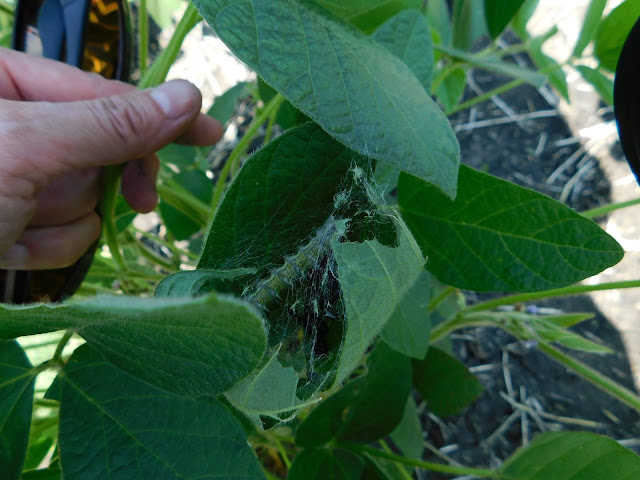Caterpillar identification 101.
The moths that lay eggs that eventually hatch into green cloverworms (Figure 1) and thistle caterpillars (Figure 2) migrated into some northwest Minnesota soybean fields this year and have been causing injury symptoms on leaves as they feed and progress through their larval stages towards pupation.
 |
| Figure 2. Thistle caterpillar rolled up in a soybean leaf it uses for protection from predators while it feeds. Photo: Angie Peltier, UMN Extension |
While some may confuse soybean or alfalfa looper larvae for green cloverworm larvae and vice versa, there is a quick way to tell them apart. Both loopers and green cloverworms have three pairs of true legs on their thorax and one pair of fleshy prolegs on their rear end, but they differ in the number of pairs of pro-legs on their abdomens. Alfalfa and soybean loopers have two pairs of abdominal prolegs (Figure 3) and green cloverworms have three pairs of abdominal prolegs (Figure 1).
Another way to tell the loopers apart from green cloverworm is that when disturbed (for example when knocking one from a plant into your hand), green cloverworm wiggles around in a surprisingly 'spirited' fashion.
Green cloverworms, thistle caterpillars, loopers, grasshoppers, and other insects feed on soybean foliage, resulting in lost photosynthetic material. As multiple defoliators can cause defoliation injury simultaneously, treatment thresholds are based on the presence of abundant defoliating insects and the combined defoliation injury severity from insects and other sources. Treatment thresholds change with time as the soybean crop progresses from vegetative (average of 30% injury) to reproductive (average of 20% injury) growth stages.
How best to estimate defoliation injury.
In order to avoid unnecessary insecticide applications that will have negligible effect on yield potential, it is recommended that one learn what 20% and 30% injury severity looks like. One thing to keep in mind: when a treatment threshold is 20% defoliation severity, this is an average of 20% severity throughout the entire plant, not just the lower leaves, or the leaves in the mid-canopy or leaves toward the top of a plant. Many insect defoliators prefer to feed on new upper leaves. It is easy to overestimate the effect of this highly visible injury on soybean yield. However, lower, previously shaded soybean leaves can compensate for lost leaf area and new leaves will be produced into the R5 stage.
From multiple plants located in multiple areas of each soybean field, collect a leaf from the lower, middle and upper canopy of each plant and estimate severity of defoliation injury. One can 'train their eye' to better estimate soybean defoliation severity by taking the "Soybean Insect Defoliation Training" quiz until comfortable. Calculate a per-plant average defoliation severity and a whole field average defoliation severity to determine whether thresholds have been reached for plants at your crop's stage of development.


Comments
Post a Comment